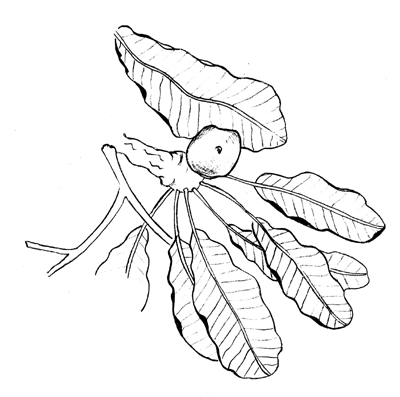Shea butter


Shea is native to tropical Africa. 12 to 20m high, its branches are short and thick, with a greyish bark, red inside, deeply sprung and the cork of which divides into small irregular quadrangular prisms, very resistant to bush fires. The floriferous branches, more or less spreading, are short, thick, with ring-shaped rolls, bearing leaves at their end only, if ever. They end up in a many-flower inflorescence in rounded corymbs. The leaves are big, isolated, membranous, covered with a brownish down when young, tough and glabrous when adult. The fruit is a greenish-yellow ellipsoidal or spherical berry. These latter are used, harvested when fully mature, in June, in the season when tornadoes bring down the ripe ones. Natives bury some of them in holes or put them in clay vases during several days : they then eat the pulp they appreciate when overripe. Shea is mainly renowned for its butter. The pulp is removed after fermentation and washing and the fruit then let to dry in the sun. The almonds are easy to crush and separate once roasted for a while in an oven. Crushed almonds produce a mixture which undergoes different processes and ultimately makes an indigenous fat. This home-made shea butter is also used locally, applied on the skin and on the hair for its moisturizing properties, and to heal multiple small affections. In the western world, refined in modern industrial conditions, shea butter goes in the making of vegetable margarines, certain chocolates and many cosmetic products.
Shea was not known in Europe before the 17 th. century. Its species name (Parkii) comes from the name of the British explorer Mungo Park who was first to make the botanical description of the plant, and from the name of Kotschy who established it was a new species. He actually called it according to the main use of the tree : butter (butyrum in Latin). Mungo Park wrote in 1797 in Trip Inside Africa :"Apart from the slaves and goods they carry for the Whites, merchants bring native iron, odorous gums and shetoulou to the coast of Gambia, which literally means "tree butter" or vegetable butter. This butter is extracted from a nut species, in boiling water, as explained later on. It resembles ordinary butter and shares the same consistency. [...] The locals use it quite a lot and it is consequently very sought after. [...]It has to be noted that spontaneous trees are still exploited nowadays, as cultures of shea have always failed.
The inhabitants were thus very busy picking the fruit of "shea" tree. [...] This tree [...] is not planted, but grows wild in the woods."
Chemical composition
Average composition in fatty acids Oleic acid 40 to 55 % Stearic acid 35 to 45 % Palmitic acid 3 to 7 % Linoleic acid 3 to 8 % Shea butter contains up to 17% unsaponifiables. The unsaponifiable fraction is composed of phenols : tocopherols, triterpenes (alpha-amyrin, lupeol, butyrospermol, parkeol),steroids (campesterol, stigmasterol, beta-sitosterol, alpha-spinasterol, delta-7-avenasterol) and hydrocarbons (2-3% karitene). It also contains terpenic alcohols.
Cosmetic uses
Like all vegetable fats, shea butter globally has softening, anti-drying and protective effects. These activities are even more noticeable due to the high content in unsaponifiables and to the content in vitamins and other elements. Rich in cinnamic acid, shea butter protects from UV rays and can thus be used in sun products. Shea butter is moreover allotted natural anti-oxidizing properties due to its content in tocopherols. It also has a regenerative activity and is considered as an excellent anti-ageing active principle. It has restructuring effects on the skin and on dry and brittle hair and can be recommended in skin and hair conditioners. In formulation, shea butter is a compound of the oily phase and can also be used as a thickening agent. Given these properties, it is a choice ingredient in :Cosmetic usage level : 5 to 20%.
- nourishing shampoos for dry and brittle, damaged and delicate hair ;
- baby hair products ;
- anti-wrinkle creams for mature and damaged skin, notably for around the eyes ;
- body massage products ;
- anti stretch-mark creams ;
- emollient creams for dry, sensitive and delicate skin ;
- sun products ;
- lip balms ;
- softening hand creams.
INCI name Shea butter (Butyrospermum Parkii) INCI name Europe Butyrosperum Parkii Customs tarification 15-15-90-60 Japan Shea butter : 523110 Refined shea butter
Organoleptic analysis Aspect Paste Colour Very pale yellow Odour Weak Physico-chemical characteristics Density at 20°C 0.8 - 0.9 Melting point 35 - 43°C Oleic acidity < 0.20 % Iodine index 55 - 71 Peroxide value < 1.0 mmole/kg Percentage of unsaponifiables 6 - 9 Citric acid content 10 ppm The standard norm of this analytical data sheet are only indicative and could undergo modifications.
Keep away from light and heat.